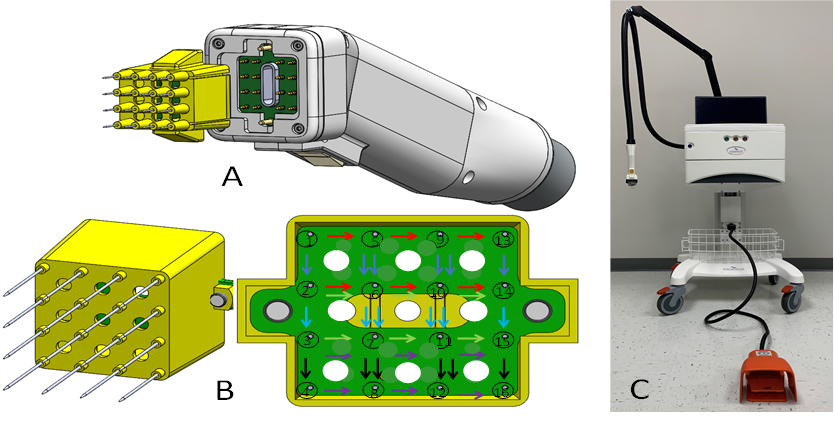Advantages:
- Novel device to perform electrically based therapies for: soft tissue ablation (irreversible electroporation; IRE), Drug Delivery (electrochemotherapy; ECT), Gene delivery (gene electro transfer; GET).
- Modular array technology integrates temperature modulation to reduce voltage requirements, impedance monitoring to control applied pulses, and independently addressable electrodes to treat targeted tissue segments.
- The device was successfully tested, e.g., for gene delivery for cancer immunotherapy and HepB DNA vaccine delivery.
Summary:
Existing electrically-based technologies for drug and gene delivery, as well as tissue ablation, are have not obtained widespread acceptance due to challenges that include controlling the electric field, achieving adequate tissue coverage, and ensuring treatment efficacy.
This next-generation electrotherapy device addresses these issues with innovative features for electrically based therapies. Firstly, it introduces moderate heat application to improve cell membrane fluidity, thereby reducing voltage requirements and reducing adverse thermal effects. Secondly, impedance monitoring ensures precise pulse control. The third innovative aspect is its independently addressable electrodes and modular array design allowing tailored treatment strategies and compensates for tissue heterogeneity. This technology was successfully tested for gene delivery in animal models, in particular to deliver cancer immunotherapy (via a plasmid designed to block PD1-PDL1 binding and a plasmid encoding IL-12), as well as for HepB DNA vaccine delivery. These findings underscore the versatility of this novel device for medical application, drug delivery and gene delivery, DNA vaccine delivery, and disease tissue ablation.

Clinical instrument, handle and electrode array for canine veterinary trial. A) Handle and replaceable electrode array. Electrode array locks onto the handle securely. B) enlarged view of the electrode array. Arrows depict pulsing sequence of the electrode array. Electrodes 1 and 2 pulse to electrode 5 and 6 then 1 and 5 pulse to 2 and 6 then the pulsing moves to the next sector and electrodes 5 and 6 pulse to 9 and 10 then 5 and 9 pulse to 6 and 10 followed by move to next sector. This continues until all sectors go through the sequence.
Desired Partnerships:
- License
- Sponsored Research
- Co-Development